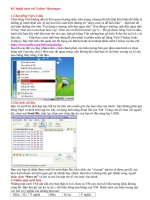BỘ SƯU TẬP TIỀN 201030 TIỀN NHÀ THANH VÀ NHÀ NGUYỄN
Bạn đang xem bản rút gọn của tài liệu. Xem và tải ngay bản đầy đủ của tài liệu tại đây (271.8 KB, 12 trang )
XX.
Chinese intervention in Tunquin, and the Nguyen
Dynasty.
At the request of the wife and son of King CHIEU-THONG, who was hiding himself in the
Cao-bang mountains, the Emperor K'IEN-LUNG ordered his armies to enter Annam and to
re-establish the former state of affairs, that is to say, to restore to the LE Dynasty the entire
territory of Tunquin of which they had been deprived by the Tay-son rebels.
The Viceroy of the Liang Kuang provinces, SUN CHE-I, was appointed commander-in-
chief of the Chinese armies, and assisted by General SHIU CHE-HENG, he entered
Annam from Kuang-si in November 1788 at the head of ten thousand Cantonese soldiers.
Another Chinese army commanded by General HU TA-KING invaded Annam from
Yunnan. They were joined by the irregular Annamese troops who had remained faithful to
the fallen dynasty, and after several easy victories following each other in rapid succession,
the Chinese commander-in-chief entered Ha-noi in Drcember of the same year and re-
instated King CHIEU-THONG on the throne.
A month afterwards, however, the rebel chief HUE entered Ha-noi by stratagem, and
having come upon the Chinese unawares, completely routed them and forced the Viceroy
and the Annamese king to re-cross the frontier into China.
The court of Peking degraded the Viceroy SUN and gave the supreme command of the
army to FU KANG-NGAN, Viceroy of the Yun-Kuei (Yunnan and Kuei-chao). The new
coinmaiidef-in-chief re-entered Annam without delay, concluded a truce with HUE, and
wrote a long report to the Emperor in support of the rebellion. Thereupon K'IEN-LUNG
issued the following edict, published in the A Ta Tsing Vui-tien in 1789. "In consequence
of a revolution King LE CHIEU-TONG lost his royal seal and became a fugitive. The
Annamese then recognized as head of the Government NGUYEN QUANG-BINH
( QUANG-TRUNG, Or HOE) who now submits to our authority and craves permission to
come to Peking to gaze upon our august Majesty. The [provincial judge of Kuang-si,
TCH'ENG-LIN, is hereby commanded to invest him with royal power in our name, and to
bestow upon him a gilt silver seal in the shape of a camel."
After the promulgation of this edict the Chinese armies were ordered to retire from Annam,
and thus closed the war.
1
No. 212. - Obverse: Can-long-thong-bao.
Reverse: An-nam. White Copper. Cast in Yunnan for the payment of the Chinese
troops.
The Nguyen Dynasty. From 1776 to the present time.
King GIA-LONG was the nephew of King DUE-TONG, THE last sovereign of
Cochinchina, and being gifted with an active mind and with great powers of organization,
he determined to reconquer the territory which had been taken possession of by the Tay-
son rebels.
His lack was at first a very changeable one, for at one time he reigned in the South of
Cochinchina with absolute power, and at another he found himself alone, persecuted,
without an army, and forced to take refuge in Siam. At last success favoured him. With the
help of the French, secured through the direct intervention of the Bishop of Adran, and
assisted by the Siamese and Cambodian armies, he not only re-occupied the former
territory of the Quang-nam Principality belonging to his family, but also took possession of
the whole of Tunquin. Out of these conquests he formed the kingdom of Annam, and in
1801 proclaimed himself king, thus founding the NGUYEN Dynasty, which is still in
power at the present day.
Since then four kings have ascended the throne. The history of their reign contains but little
worthy of note; moreover, it is' still of too recent a date to be dealt with impartially. These
four kings are principally remarkable for their hatred towards foreigners and for their
persecution of the Christians. It is only through the pressure of European armies that they
have consented to open several ports to foreign trade, and at this very moment the country
seems to be passing through a crisis, menaced as it is by the intervention of the French in
Tunquin, who may possibly annex it in the same way as they annexed Lower Cochinchina
twenty-five years ago.
2
No. 213. - Obverse: Gia-long-thong-bao.
Reverse: plain. Three kinds of cash, made of copper, lead, or zinc.
No. 214. - Same as before, but of larger size. Copper mixed with tin.
No. 215. - Obverse: Same as No. 213.
Reverse: without rim. Some are made of white copper, others of dark red copper.
3
No. 216. - Obverse: Same as No. 213.
Reverse: A dot above the hole.
No. 217. - Obverse: Same as No. 213.
Reverse: A dot on the right of the hole.
No. 218. - Obverse: Same as No. 213.
Reverse: A dot on the left of the hole.
No. 219. - Obverse: Same as No. 213.
Reverse: Two crescents above and below the hole.
4
No. 220. - Obverse: Same as No. 213.
Reverse: Two crescents on the right and left of the hole.
No. 221. - Obverse: Same as No. 213.
Reverse: A dot and a crescent on the right of the hole.
No. 222. - Obverse: Same as No. 213.
Reverse: with a double rim.
All the above coins, from No. 216 to 222, are made of copper mixed with tin.
5









